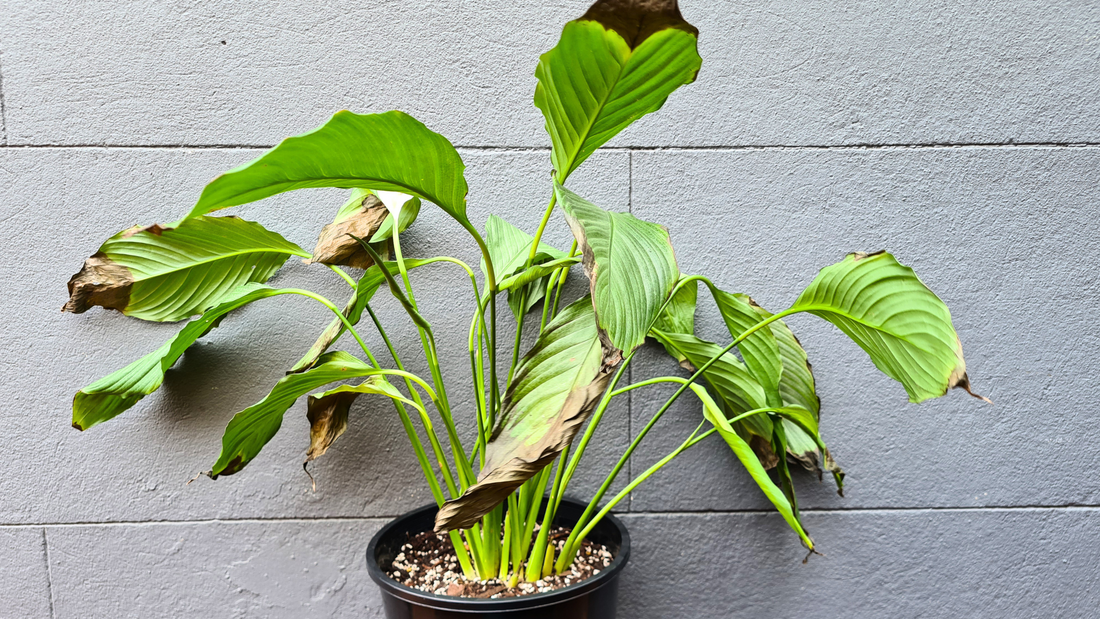
How much water do indoor plants actually need?
Felicity MoodyAnswer: Less than you think!
The most common plant issue I see at Wattle & Bee is overwatering. But it's not as simple as determining the precise amount of millilitres and timing schedule to water them. Read on to find out the best way to water your plants.
Yes plants need water to live... but too much can kill them!
Each plant has different watering requirements.
Why is overwatering bad?
- Lack of Oxygen - The roots need air pockets with oxygen around them in order to take up nutrients and, ironically, water. So even if the plants look droopy and dehydrated but the soil is wet, it doesn't mean they need more!
- Disease - Diseases such as root rot (a type of fungus) love soil that's always moist or water logged. They will start decaying the roots of the plant until the plant is either treated or dies.
- Pests - A variety of pests like wet soil such as Fungus Gnats (those annoying little black flies that can appear around your plants). They actually breed and multiply in wet soil!
- Lower Immunity - With an inability to take up water and nutrients effectively plus being attacked by disease and pests, the plant's immunity starts to decrease and will lead them to eventually die.
Pesky Fungus Gnats love moist soil.
Factors that affect watering:
- Light - Plants that are kept right near a window will be getting more light than a plant in a darker corner and therefore they will be photosynthesising faster. A part of photosynthesis is taking water and nutrients up from the soil, so the faster they are photosynthesising, the faster they are drying up the soil in their pots. So plants near a window, will require more water than a plant in low light.
- Temperature - Photosynthesis will slow down or speed up depending on the temperature. Think of how much we sweat on a hot day and need to keep our liquids up... plants are the same! And conversely we tend not to sweat as much when it's chilly outside. So make sure you adjust your watering depending on the seasons and also if you move house, your new place may be hotter or colder so the amount your plants need may change.
- Size - A plant is growing in a 100mm diameter pot is going to need much less water than one that is growing in a 400mm pot. So you will need to adjust how much you give them, according to the pot size. You want to cover the soil and allow it to soak through but don't let the plants sit in any excess water, you can tip out extra water in the saucer or cover pot. Or take your plants to a sink or shower and let the excess fully drain out before you put them back.
- Species - Plants have evolved to live in a huge range of environments all over the world and no two plant species are identical. So work out what type of plant you have (is it a succulent? Is it a tropical plant? etc.) and then make sure you're watering according to the species need. Try and replicate their natural environment as much as you can. So very little water is need for a Snake Plant for instance, but regular watering and misting is great for Ferns.
- Soil - The material the plant is growing in will affect how much water stays in the soil. A rich, potting mix with plenty of compost will absorb and retain much more water than a more porous orchid bark or perlite mixture where the water will flow through a lot faster. Most indoor plants actually benefit from a good mix of both water-retaining soil and well-draining materials like perlite.
Not much water needed here...
How to tell if your plant needs more or less water:
- The Finger Test - Sometimes you gotta get down and dirty with your plants. So take off the gloves and poke your finger into the soil and wiggle it down to at least a couple of inches or over a couple of knuckles. What can you feel? Is it moist and tacky? Or is it dry and crispy? Take your finger out. Is there soil stuck to it? If yes, it's probably on the wet side.
- Moisture Meter - This simple device is a game changer! Pop it down into the soil in your pot and in seconds you will get an accurate reading of how wet or dry your soil actually is. It takes the guess work out of it and is how I water all my plants! Most plants actually like to get into the dry zone for a few days to a week so don't panic if the meter says dry.
- Research - Just like a new pet, a new plant requires a bit of research to figure out the best care requirements. So have a bit of a look through some plant books like my 'Plant Bible' Plantopedia or come chat to your friendly neighbourhood horticulturalist (hi!). Googling answers can sometimes be a bit overwhelming and there is a lot of misinformation out there but if you can find some reputable sources like botanic gardens, nurseries, government or gardening societies then you can be confident that they are more reliable.

Try watering over a sink and let the excess drain away.
Final Tip
If in doubt... don't water! An under-watered plant is generally going to be much less susceptible to disease and pests than an overwatered plant (but don't leave it dry forever!).
If you would like to learn more, come along to one of our Plant First Aid classes for a fun hands-on day of learning how to recognise the symptoms of a sick plant and how best to treat them.
@wattleandbee The no. 1 killer of indoor plants! How do you know when you're drowning your plants? Find out! #planttips #indoorplants #planttok #gardening #watering #plantshop ♬ Pop beat BGM / long version(1283324) - nightbird_bgm



